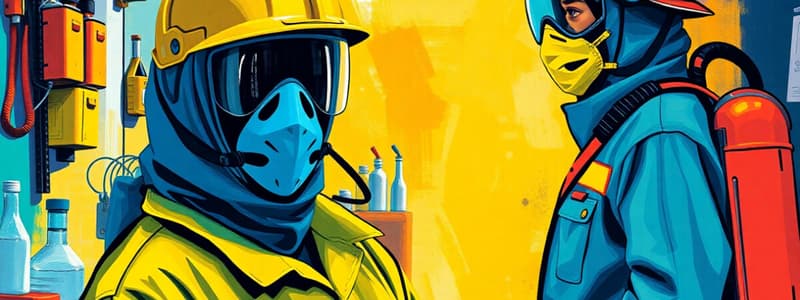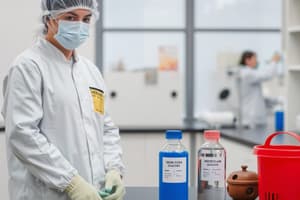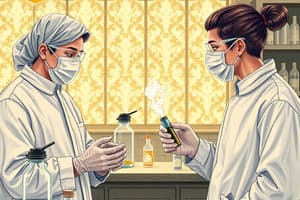Podcast
Questions and Answers
Which personal protective equipment is specifically used to prevent eye injuries during experiments?
Which personal protective equipment is specifically used to prevent eye injuries during experiments?
- Gloves
- Safety spectacles (correct)
- Lab coat
- Fume cupboard
What is the purpose of a fire blanket in the laboratory?
What is the purpose of a fire blanket in the laboratory?
- To absorb spills
- To extinguish small fires (correct)
- To cool down hot equipment
- To block fumes
Which of these actions should NOT be taken in the laboratory?
Which of these actions should NOT be taken in the laboratory?
- Eating while conducting experiments (correct)
- Keeping exits and passages clear
- Washing hands after completing an experiment
- Wearing safety spectacles when handling chemicals
What equipment should be used to provide a secure environment when working with hazardous fumes?
What equipment should be used to provide a secure environment when working with hazardous fumes?
What is the main function of a first aid box in the laboratory?
What is the main function of a first aid box in the laboratory?
Which action is appropriate when a laboratory accident occurs?
Which action is appropriate when a laboratory accident occurs?
Why should long hair be tied back during laboratory experiments?
Why should long hair be tied back during laboratory experiments?
What should you do if you accidentally spill a chemical in the laboratory?
What should you do if you accidentally spill a chemical in the laboratory?
What does covering the flame with a metal lid primarily remove to extinguish the fire?
What does covering the flame with a metal lid primarily remove to extinguish the fire?
Which of the following methods effectively removes fuel from the fire triangle?
Which of the following methods effectively removes fuel from the fire triangle?
What is the primary condition removed when using a fire extinguisher?
What is the primary condition removed when using a fire extinguisher?
Which method involves the removal of both high temperature and oxygen to extinguish a fire?
Which method involves the removal of both high temperature and oxygen to extinguish a fire?
What immediate action should be taken if chemicals splash into the eyes?
What immediate action should be taken if chemicals splash into the eyes?
What effect does covering a burning candle with an inverted gas jar have?
What effect does covering a burning candle with an inverted gas jar have?
What is the purpose of clearing a strip of plants as a fire prevention method?
What is the purpose of clearing a strip of plants as a fire prevention method?
Which fire-fighting equipment primarily removes oxygen?
Which fire-fighting equipment primarily removes oxygen?
Which element is NOT part of the fire triangle?
Which element is NOT part of the fire triangle?
In the context of the fire triangle, what role do ashes play in the burning process of charcoal?
In the context of the fire triangle, what role do ashes play in the burning process of charcoal?
In case of a cut in the laboratory, the first recommended action is to:
In case of a cut in the laboratory, the first recommended action is to:
What essential properties form the fire triangle necessary for a fire to occur?
What essential properties form the fire triangle necessary for a fire to occur?
What should someone do after breaking a glass apparatus in the laboratory?
What should someone do after breaking a glass apparatus in the laboratory?
Which of the following statements correctly identifies a method to extinguish a fire?
Which of the following statements correctly identifies a method to extinguish a fire?
In a barbecue, how does fanning the charcoal enhance combustion?
In a barbecue, how does fanning the charcoal enhance combustion?
What is the primary purpose of wearing safety spectacles in a laboratory?
What is the primary purpose of wearing safety spectacles in a laboratory?
Which condition in the fire triangle is primarily disrupted when a fire is smothered?
Which condition in the fire triangle is primarily disrupted when a fire is smothered?
Which of the following is an action NOT recommended in the event of a heat burn?
Which of the following is an action NOT recommended in the event of a heat burn?
What critical factor about the candle suggests high temperature is required for combustion?
What critical factor about the candle suggests high temperature is required for combustion?
Why is it important to remain calm during a laboratory accident?
Why is it important to remain calm during a laboratory accident?
Which of the following best describes 'fuel' in the context of fire safety?
Which of the following best describes 'fuel' in the context of fire safety?
Which action is appropriate when heating a test tube in the laboratory?
Which action is appropriate when heating a test tube in the laboratory?
What should you do before handling a chemical with a hazard warning symbol?
What should you do before handling a chemical with a hazard warning symbol?
In case of an accident in the laboratory, what is the first action you should take?
In case of an accident in the laboratory, what is the first action you should take?
Which of the following statements about electrical safety is true?
Which of the following statements about electrical safety is true?
What safety precautions should be taken when dealing with corrosive materials?
What safety precautions should be taken when dealing with corrosive materials?
What should you do if a chemical container is marked as toxic?
What should you do if a chemical container is marked as toxic?
What does the hazard symbol for flammable indicate?
What does the hazard symbol for flammable indicate?
What does the symbol for harmful chemicals advise?
What does the symbol for harmful chemicals advise?
Flashcards
Laboratory Safety Rules
Laboratory Safety Rules
Guidelines designed to prevent accidents and ensure a safe environment in a laboratory.
Hazard Warning Symbols
Hazard Warning Symbols
Symbols displayed on chemical containers to alert users to potential dangers and necessary precautions.
Flammable
Flammable
A substance easily ignited and capable of burning rapidly.
Oxidizing
Oxidizing
Signup and view all the flashcards
Corrosive
Corrosive
Signup and view all the flashcards
Irritant
Irritant
Signup and view all the flashcards
Harmful
Harmful
Signup and view all the flashcards
Toxic
Toxic
Signup and view all the flashcards
Safety Equipment
Safety Equipment
Signup and view all the flashcards
Personal Protective Equipment (PPE)
Personal Protective Equipment (PPE)
Signup and view all the flashcards
Fire Extinguisher
Fire Extinguisher
Signup and view all the flashcards
Fume Cupboard
Fume Cupboard
Signup and view all the flashcards
Potential Danger
Potential Danger
Signup and view all the flashcards
Report All Accidents
Report All Accidents
Signup and view all the flashcards
Do Not Leave Experiments Unattended
Do Not Leave Experiments Unattended
Signup and view all the flashcards
Cuts
Cuts
Signup and view all the flashcards
Heat burns
Heat burns
Signup and view all the flashcards
Chemical splash on skin
Chemical splash on skin
Signup and view all the flashcards
Chemical splash in eyes
Chemical splash in eyes
Signup and view all the flashcards
What are the necessary conditions for a fire?
What are the necessary conditions for a fire?
Signup and view all the flashcards
Fuel
Fuel
Signup and view all the flashcards
High Temperature
High Temperature
Signup and view all the flashcards
Oxygen
Oxygen
Signup and view all the flashcards
Fire Triangle
Fire Triangle
Signup and view all the flashcards
How does fanning a fire make it burn brighter?
How does fanning a fire make it burn brighter?
Signup and view all the flashcards
Methods to Extinguish a Fire
Methods to Extinguish a Fire
Signup and view all the flashcards
Water to Extinguish a Fire
Water to Extinguish a Fire
Signup and view all the flashcards
Blanket to Extinguish a Fire
Blanket to Extinguish a Fire
Signup and view all the flashcards
Removing Oxygen
Removing Oxygen
Signup and view all the flashcards
Removing Fuel
Removing Fuel
Signup and view all the flashcards
Removing Heat
Removing Heat
Signup and view all the flashcards
Fire Blanket
Fire Blanket
Signup and view all the flashcards
Sand Bucket
Sand Bucket
Signup and view all the flashcards
Why are laboratory safety rules important?
Why are laboratory safety rules important?
Signup and view all the flashcards
Study Notes
Safety in the Laboratory
- Laboratories are used for experiments
- Safety rules are necessary for safe work
- Laboratories have equipment for water, electricity, and gas
- Safety equipment is essential during experiments
Personal Protective Equipment
- Safety spectacles are important eyewear
- Gloves provide hand protection
- Laboratory coats offer body protection
Fire-Fighting Equipment
- Fire extinguishers are used to put out fires
- Sand buckets help extinguish small flames
- Fire blankets provide insulation from flames
Other Equipment
- First-aid boxes have medical supplies for injuries
- Eye wash bottles clean chemical splashes from eyes
- Fume cupboards vent harmful gases
Laboratory Safety Rules
- Follow teacher instructions
- Keep exits clear
- Maintain a clean lab
- Use safety equipment (e.g., safety spectacles) for heating or mixing substances
- Tie up long hair and fasten school ties to prevent fires
- Thoroughly wash hands after experiments
- Report any accidents immediately
Potential Dangers in the Laboratory
- Activities in the lab can be dangerous, so be careful
- Potential dangers should be identified and discussed
- Discuss with classmates and suggest how to avoid problems
Necessary Conditions for Fire
- Fuel, high temperature, and oxygen are needed for a fire to start
- These three conditions create a fire triangle
Handling Fire in the Laboratory
- Keep calm and report fires to the teacher immediately
- Teachers know the proper way to put fires out
- Understanding fire conditions is vital
Handling Common Laboratory Accidents
- Keep calm during accidents
- Report accidents to the teacher immediately
- Follow the teacher's instructions for proper actions
- Clean and attend to cuts and burns
- Wash splashed chemicals off skin and eyes
Hazard Warning Symbols
- Chemical containers have hazard symbols
- Be mindful of dangerous chemicals
- Pay attention to symbols and handle chemicals carefully
- Follow necessary safety precautions when using chemicals
- Follow safety precautions as directed by teachers
Methods of Putting Out Fires
- Turn off gas stoves
- Cover flames with metal lids
- Spray water onto fires
- Removing any one condition (fuel, oxygen or high temperature) ends a fire
Studying That Suits You
Use AI to generate personalized quizzes and flashcards to suit your learning preferences.




